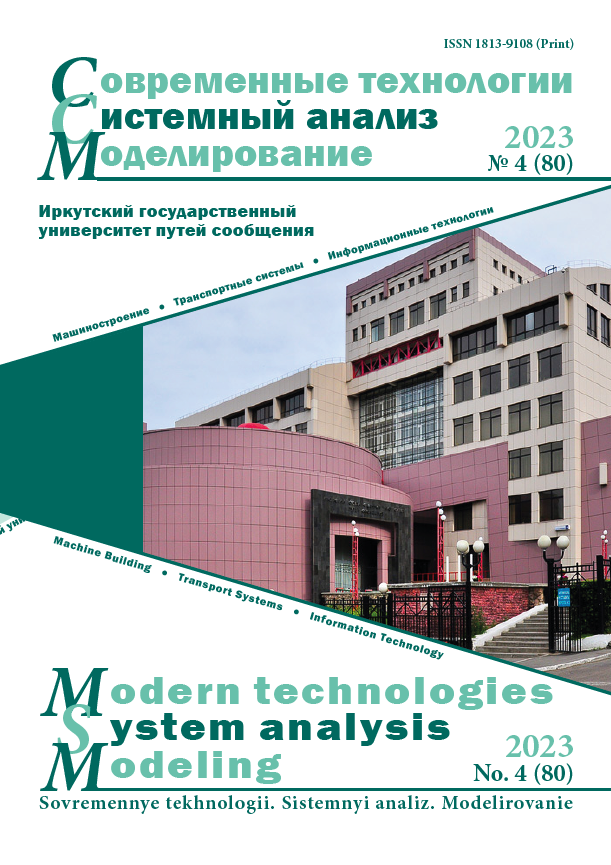Research of gas dynamic processes in electro pneumatic brakes on an electric train ED9M
Keywords:
motor wagon rolling stock, braking system, gas dynamic processes, pressure sensor, analog signal recorder, adaptive brake control algorithmAbstract
In the process of developing an algorithm for adaptive control of pushing the braking pads of passenger rolling stock during electropneumatic braking, it became necessary to take into account the gas-dynamic processes occurring in the braking system. For this, an experiment was conducted at the Irkutsk motor wagon depot on the ED9M electric train during its parking using special digital equipment. In the course of the experiment, a certain number of braking cycles were performed in order to identify delays between the supply of the control action by the driver's crane and the beginning of filling the brake cylinder or its discharge, the number of possible stages of discharge of the brake cylinder with manual control of electropneumatic brakes was also revealed to clarify the adaptive braking algorithm. Pressure sensors were connected at seven points of the brake system: in the brake cylinder, false brake cylinder, working chamber of the air distributor, feed and spare tanks, feed line and brake line. The signal from the pressure sensors was sent to the data recording and storage device. The moment the control action was applied to the electropneumatic braking system by transferring the driver's crane handle to the release, overlap and braking positions was recorded by light sensors installed on the overlap and braking lamps on the control panel in the driver's cabin. As a result of the experiment, the possibility of using an adaptive braking algorithm for controlling electropneumatic brakes was confirmed in terms of their speed and controllability.
References
Стратегия развития Холдинга «РЖД» на период до 2030 года // Волгоградский Терком Роспрофжел : сайт. URL : https://volgograd-terkom34.ru/wp-content/uploads/2017/05/Стратегия-развития-ОАО-РЖД-до-2030-года.pdf (Дата обращения 14.11.2023).
Алгоритм адаптивного управления тормозным нажатием пассажирского подвижного состава / П.Ю. Иванов, Е.Ю. Дульский, А.А. Корсун и др. // Транспорт: наука, техника, управление. Научный информационный сборник. 2022. № 5. С. 60¬64.
Об утверждении правил тяговых расчетов для поездной работы : распоряжение ОАО «РЖД» от 12.05.16 № 867р (ред. 02.02.2018). Доступ из справ.-правовой системы АСПИЖТ в локал. сети.
Frea M., Tione R. Adaptive wheel slide protection algorithms. URL : download.aspx?id=81470145-a0bc-4007-b100-75b39a0d6dbf (Дата обращения 14.11.2023).
Универсальная система автоведения электровозов пассажирского движения. Руководство по эксплуатации // ООО «АВП Технология» : сайт. URL : https://avpt.ru/upload/RE_USAVPP.pdf (Дата обращения 14.11.2023).
Крылов В.П., Крылов В.В. Автоматические тормоза подвижного состава. М. : Транспорт, 1983. 360 с.
Асадченко В.Р. Автоматические тормоза подвижного состава. М. : Маршрут, 2006. 392 с.
Об утверждении Правил технической эксплуатации железных дорог Российской Федерации : приказ Минтранса России № 250 от 23.06.2022. Доступ из справ.-правовой системы АСПИЖТ в локал. сети.
Правила технического обслуживания тормозного оборудования и управления тормозами железнодорожного подвижного состава : утв. Советом по ж.-д трансп. государств-участников Содружества : протокол от 6-7 мая 2014 г. № 60 (приложение № 18). Доступ из справ.-прав. системы АСПИЖТ в локал. сети.
Сравнительный анализ тормозных систем подвижного состава с однотрубным и двухтрубным питанием / П.Ю. Иванов, Е.Ю. Дульский, А.А. Хамнаева и др. // Вестн. Ростов. гос. ун-та путей сообщ. 2020. № 3 (79). С. 35–42.
Применение радиочастотного тракта для регистрации импульсных сигналов с пьезодатчика / О.В. Малышкина, С.И. Пугачев, С.О. Сегеда и др. // Морские интеллектуальные технологии. 2015. № 1-1(27). С. 49–53.
Исследование температуры тормозных колодок с разной степенью износа в процессе фрикционного торможения / П.Ю. Иванов, А. М. Худоногов, Е. Ю. Дульский и др. // Вестн. Урал. гос. ун-та путей сообщ. 2020. № 3 (47). С. 27–34.
A methodology to predict thermomechanical cracking of railway wheel treads: from experiments to numerical predictions / A. Esmaeili, M.S. Walia, K. Handa et al. // International Journal of Fatigue. 2017. Vol. 105. Р. 71–85.
Hamdaoui A., Jaddi El.H. Effects of the brake shoe friction material on the railway wheel damage // MATEC Web of Conferences. 2018. Vol. 149. Р. 1–4.
Tudor A., Radulescu C., Petre I. Thermal effect of the brake shoes friction on the wheel/rail contact // Tribology in industry. 2003. Vol. 25. Р. 27–32.
Talati F., Jalalifar S. Analysis of heat conduction in a disk brake system // Heat Mass Transfer. 2009. Vol. 45. Р. 1047–1059.
Schrader H.J. The friction of railway brake shoes at high speed and high pressure // University of Illinois bulletin. 1938. Vol. 35. No 72. URL : https://core.ac.uk/download/pdf/4814283.pdf (Дата обращения 14.11.2023).
Balotin J.G., Neis P.D., Ferreira N.F. Analysis of the influence of temperature on the friction coefficient of friction materials // ABCM Symposium Series in Mechatronics. 2010. Vol. 4. Р. 898–906.


